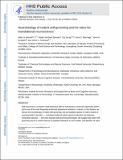Neurobiology of rodent self-grooming and its value for translational neuroscience
Author(s)
Kalueff, Allan V.; Stewart, Adam Michael; Song, Cai; Berridge, Kent C.; Fentress, John C.; Graybiel, Ann M; ... Show more Show less
Downloadnihms777621.pdf (921.3Kb)
OPEN_ACCESS_POLICY
Open Access Policy
Creative Commons Attribution-Noncommercial-Share Alike
Terms of use
Metadata
Show full item recordAbstract
Self-grooming is a complex innate behaviour with an evolutionarily conserved sequencing pattern and is one of the most frequently performed behavioural activities in rodents. In this Review, we discuss the neurobiology of rodent self-grooming, and we highlight studies of rodent models of neuropsychiatric disorders-including models of autism spectrum disorder and obsessive compulsive disorder-that have assessed self-grooming phenotypes. We suggest that rodent self-grooming may be a useful measure of repetitive behaviour in such models, and therefore of value to translational psychiatry. Assessment of rodent self-grooming may also be useful for understanding the neural circuits that are involved in complex sequential patterns of action.
Date issued
2017-11-14Department
Massachusetts Institute of Technology. Department of Brain and Cognitive Sciences; McGovern Institute for Brain Research at MITJournal
Nature Reviews Neuroscience
Publisher
Nature Publishing Group
Citation
Kalueff, Allan V. “Neurobiology of Rodent Self-Grooming and Its Value for Translational Neuroscience.” Nature Reviews Neuroscience 17, 1 (December 2015): 45–59 © 2016 Macmillan Publishers Limited
Version: Author's final manuscript
ISSN
1471-003X
1471-0048